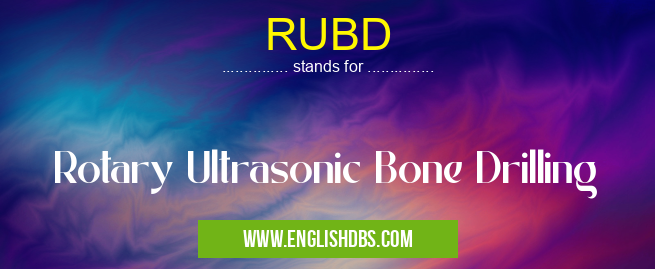What does RUBD mean in UNCLASSIFIED
RUBD stands for Rotary Ultrasonic Bone Drilling, a specialized surgical technique utilized in various medical disciplines, including orthopedics, dental surgery, and neurosurgery. It involves the use of a rotating ultrasonic handpiece to precisely drill and cut bone.

RUBD meaning in Unclassified in Miscellaneous
RUBD mostly used in an acronym Unclassified in Category Miscellaneous that means Rotary Ultrasonic Bone Drilling
Shorthand: RUBD,
Full Form: Rotary Ultrasonic Bone Drilling
For more information of "Rotary Ultrasonic Bone Drilling", see the section below.
Principle of Operation
RUBD employs a high-frequency ultrasonic vibration superimposed onto the rotational motion of a surgical drill. The ultrasonic vibrations create microscopic oscillations that facilitate bone removal with minimal damage to surrounding tissues. This allows for highly precise and controlled bone sculpting and cutting.
Advantages of RUBD
- Precision: RUBD provides superior precision compared to traditional drilling techniques, enabling surgeons to perform intricate procedures with greater accuracy.
- Minimized Tissue Damage: The ultrasonic vibrations minimize heat generation and tissue trauma, reducing the risk of complications such as bleeding and nerve damage.
- Faster Cutting: The high-frequency vibrations allow for faster bone removal, reducing surgical time and minimizing patient discomfort.
- Improved Healing: RUBD preserves the bone's vascularity and promotes faster healing by minimizing tissue disruption.
- Versatile Applications: RUBD has a wide range of applications, including bone grafting, joint replacement, spinal surgery, and dental procedures.
Essential Questions and Answers on Rotary Ultrasonic Bone Drilling in "MISCELLANEOUS»UNFILED"
What is Rotary Ultrasonic Bone Drilling (RUBD)?
RUBD is a surgical technique that utilizes a high-frequency ultrasonic oscillator to drive a rotating bone drill. This combination of ultrasonic vibrations and rotation allows for precise and efficient bone removal while minimizing tissue damage.
What are the advantages of RUBD over traditional drilling methods?
RUBD offers several advantages over traditional drilling, including:
- Reduced thermal damage: The ultrasonic vibrations generate minimal heat, reducing the risk of bone necrosis.
- Improved cutting efficiency: The combination of rotation and ultrasonic vibrations allows for faster and more precise bone removal.
- Enhanced visualization: The ultrasonic vibrations create a cavitation effect that helps clear debris from the surgical site, providing better visibility.
- Reduced postoperative pain: The reduced tissue damage associated with RUBD can lead to less pain and discomfort after surgery.
What are the applications of RUBD?
RUBD is commonly used in a variety of surgical procedures, including:
- Orthopedic surgery: Bone preparation for joint replacements and fracture repair.
- Neurosurgery: Skull base surgery and spinal decompression.
- Maxillofacial surgery: Bone contouring and implant placement.
- Plastic surgery: Bone reduction and reshaping.
Are there any risks associated with RUBD?
As with any surgical procedure, there are potential risks associated with RUBD, including:
- Tissue damage: Excessive use or improper technique can lead to damage to surrounding tissues.
- Bleeding: Bone removal can cause bleeding, which may require additional surgical intervention.
- Infection: The surgical site can become infected if proper sterile technique is not followed.
Who is a good candidate for RUBD?
The suitability of RUBD depends on the specific surgical procedure and the patient's overall health. It is generally recommended for patients who require precise bone removal with minimal tissue damage.
Final Words: RUBD is an innovative and versatile surgical technique that offers numerous advantages over traditional bone drilling methods. Its precision, reduced tissue damage, faster cutting capabilities, and improved healing outcomes make it an ideal choice for various surgical procedures.
